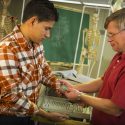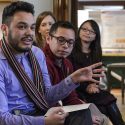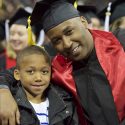Honoring Morgridge Center’s 10th anniversary
Editor’s note: The Morgridge Center for Public Service celebrates 10 years at UW–Madison this year. In the spirit of recognizing past service efforts at UW–Madison and in the Madison community, detailed below are 10 notable contributions the Morgridge Center has helped achieve since its inception.
A Decade of Accomplishments
“Hooked on education:” The Morgridge Family
In 1994, Tashia Morgridge told former UW–Madison Chancellor David Ward she wanted to help create a center for public service at her alma mater. Two years later, after proposals, planning and a $3 million donation from the Morgridges, the Morgridge Center was born.
“The Morgridge Center is really Tashia’s baby,” says Randy Wallar, assistant director of the Morgridge Center. “She is a graduate of the UW education school, so she has a really strong interest in education both in and out of the classroom.”
After its initial creation, the Morgridges continued their commitment to the center, donating another $2 million as well as $2.5 million to renovate the center’s new home, the Red Gym.
Mary Rouse, former director of the center and assistant vice chancellor emerita, calls the Morgridges “international philanthropists.”
“The Morgridges support educational interests all over the world. They are completely hooked on education,” says Rouse. “They see college students as key in both fostering civic engagement and keeping our democracy strong.”
John Morgridge says they see public service as a “win-win situation.”
“Tashia and I believe that when public service is done well, everyone benefits,” Morgridge says. “Those of us who participate in public service activities benefit by broadening and deepening our understanding of our communities…those individuals and organizations that are the recipients of public service benefit because they have access to additional talents, time and energies.”
Learning through doing: Service learning and community-based research
Service-learning courses provide the opportunity for students to participate in organized service activities as part of their normal courses and allow students to reflect on the activity to gain further understanding of course content and an enhanced sense of civic responsibility. During the past 10 years, the Morgridge Center has facilitated the use of service-learning courses in combination with community-based research, where community organizations work with academic groups to produce knowledge that is good for the community.
“We try to infuse the curriculum with opportunities for students through partnerships with departments and colleges,” says Wallar.
Currently, more than 100 service-learning and community-based research courses exist at UW–Madison in about 50 different departments, in topics such as global health, biology education and landscape ecology.
Service around the world: Peace Corps
The second day of the Morgridge Center’s 10th anniversary celebration will be almost exclusively dedicated to the Peace Corps, with a dinner and ceremony in honor of past graduates of the program from UW–Madison. UW–Madison has been at or near the top of the list of institutions that have contributed the most members to the Peace Corps for more than 20 years, and the Morgridge Center has played a vital role in promoting Peace Corps opportunities on campus.
“Peace Corps volunteers need volunteer experience prior to joining, and that’s important for a number of reasons,” says Greg Pepping, UW–Madison’s Peace Corps campus recruiter. “On this campus, the Morgridge Center is the best way for students to learn how to get involved with community service. That makes a huge difference here, not only in the number of people who serve in the Peace Corps, because they ‘feel’ what service can do for others and for themselves, but also in the quality of Peace Corps applicants from UW–Madison. They’re uniquely qualified to excel as Peace Corps volunteers if they’re already engaged in service and leadership. And all of that starts at the Morgridge Center.”
In 2001, Madison was one of three cities around the country that garnered the honor of holding a ceremony for the Peace Corps’ 40th anniversary, mainly because of the 2,500 UW alumni who have participated in this historic program.
Grants for innovation: Wisconsin Idea Undergraduate Fellowships
Since 1999, the center has supported the Wisconsin Idea Undergraduate Fellowships, providing opportunities for UW–Madison students to expand their reach, share their expertise, serve the community and promote learning outside the classroom. This program offers support to students who pursue innovative projects and work with university faculty or community organizations to collaborate for service learning and community-based research.
This year, projects include improving water quality through filtering in parts of Uganda; addressing determinants of health in the Allied Drive neighborhood in Madison; and creating an atlas of the state’s medical providers using geographical information systems technology.
The projects that have been initiated with the Morgridge Center’s help since the program’s inception have allowed Wisconsin students to carry the ideas and concepts they have learned at UW–Madison beyond the boundaries of the university, the state and the country, helping to expand the model of the Wisconsin Idea.
Students bring hope to Madison area schools: Schools of Hope
In 2004, the Morgridge Center joined other Madison area organizations in the fight to close the educational gap between low-income middle-school children and their peers through the tutoring program Middle Schools of Hope. In three years, the coalition of Madison higher education institutions and community organizations has expanded Schools of Hope to include, in addition to the original 20 elementary schools, 11 middle schools and two high schools along with more than 600 UW–Madison student volunteers.
The coalition was able to support this increase thanks to a grant from the Wisconsin Campus Compact, an organization of 36 Wisconsin educational institutions that seeks to increase public service in today’s students. The grant brought AmeriCorps VISTA worker Katherine Bolton to the Morgridge Center to help recruit students and foster the partnership.
“I think Schools of Hope gives the students a chance to really be listened to,” Bolton says. “It’s not that failing students can’t achieve, it’s their environment. Having a tutor helps a lot. It really empowers the student.”
Bolton adds the program also benefits the volunteers.
“The volunteers realize what a difference they can make,” Bolton adds. “They have these really huge ‘I-want-to-change-the- world’ goals and they start to realize they can.”
The Wisconsin Idea in South Madison: Campus-Community Partnership

During a Science is Fun outreach workshop, graduate student volunteer Mike Boll, left, teaches Jacob Zimmerman how to make a working battery using strips of copper and zinc placed in a beaker of chemical solutions. The weekend event is one of many such family-focused activities held at the UW Space Place at Villager Mall in south Madison. Space Place is part of a campus-community partnership designed to create opportunities for children on the south side of Madison. Photo: Jeff Miller
In 2001, the Campus Community Partnership opened one office in Villager Mall, after the South Metropolitan Planning Council — a southside community organization — asked the university to for support in helping them address growth and development issues. The partnership combined the expertise of the university with the talent of the South Park Street community to solve some of the neighborhood’s problems.
In 2003, the partnership, which includes the Morgridge Center, UW–Madison, Madison Area Technical College and Edgewood College, doubled its office space to include a wider variety of services ranging from legal services and financial education to a space discovery program.
“We have been able to provide technical and professional expertise to residents so they can reach their goals, whether it is a better-looking street to more pedestrian safety to expanding businesses to creating opportunities for their kids,” says Lamarr Billups, senior special assistant to the chancellor and director of community relations. “The community has used the expertise to help them achieve their own development goals.”
Community/university collaboration: Volunteeryourtime.org
Staff at the Morgridge Center for Public Service can help anyone find the service opportunity that’s right for them. Opportunities include local volunteering, special service programs and service learning. To learn more visit the Morgridge Center Web site, call 263-2432, or stop by the center in Room 154 of the Armory and Gymnasium.
In one Web site, a partnership among the Morgridge Center, the United Way of Dane County, Madison Area Technical College, Edgewood College and RSVP of Dane County centralizes thousands of volunteer opportunities in the Dane County area. This partnership is the first of its kind in the nation between the United Way and an institution of higher learning and is serving as a model for other universities.
UW–Madison, through the Morgridge Center, provides almost 50 percent of the volunteers accessed through the site, illustrating the importance and value of its position as a founding member.
Service learning and fun outside the classroom: Alternative Breaks

UW–Madison students (left to right) Devon Heim, Jessica Langer and Kelly Patterson work together to transport dirt and create a new garden at the LUPE office outside of San Juan, Texas. In February 2006, the students participated in the Alternative Breaks program through the Morgridge Center and the Wisconsin Union Directorate; the program provides students with service-learning opportunities all over the United States. Photo: Niki Fritz
The student-run Alternative Breaks program works with the Morgridge Center and the Wisconsin Union Directorate to give students volunteer experiences that combine service learning, student leadership and culturally diverse locations to create educational and life-changing experiences. Each year more than 250 students volunteer for three days to two weeks in locations across the United States, helping community organization and also broadening their education.
In 1990, a group of students created the program to give students a chance to learn outside the classroom. Today the program offers volunteer opportunities from a homeless shelter in Boston to an immigrant outreach organization in San Juan, Texas.
“Alternative Breaks are important to every students’ cultural education,” says John Barnhardt, Alternative Breaks director. “Alternative Breaks gives students the opportunity to live and work in elements that they may never have the opportunity to do again. Our organization introduces many students to the idea of service learning, and is the beginning of many students’ careers in service work.”
A fun, free concert for UW volunteers: the 10,000 Hours Show
On Saturday, April 21, more than 750 student volunteers will enter the Orpheum for a free concert, UW–Madison’s first 10,000 Hours Show, to celebrate the accomplishment of their goal: 10,000 hours volunteered by UW students in one year. Even though UW–Madison student and Morgridge Center peer adviser Katy Resop has been planning the event for more than a year, she still can’t believe it is a reality.
“I never thought by spring 2007 we would have $30,000 and 750 volunteers. That really shows something about this campus and its students,” Resop says. “Without the Morgridge Center’s support, the show would not happen. They have really made it a priority.”
Although the free concert is a reward for students volunteering 10,000 hours, Resop says the event really isn’t about the concert or the 10,000 hours.
“10,000 hours is a numerical goal that is visible. The real goal is to get people to volunteer and to make lifelong volunteers,” Resop says.
Looking to the future: The Wisconsin Institute for Discovery and the Morgridge Institute for Research
Made possible by a $50 million donation by the Morgridges, the largest gift ever to benefit the university, along with matching gifts from the Wisconsin Alumni Research Foundation (WARF) and the state, the Morgridge Institute for Research — in collaboration with the Wisconsin Institute for Discovery — is slated to start in 2010.
The Morgridge Institute for Research is the private arm of the partnership, generating collaborative research that will spur new inventions, initiate stem cell explorations, look into new treatments and cures for disease, and aid economic development in the region, all benefiting the state of Wisconsin and the University community. The public arm, the Wisconsin Institute for Discovery, will work to promote interdisciplinary research to amplify the abilities and possibilities for UW–Madison students and faculty.
Subscribe to Wisconsin Ideas
Want more stories of the Wisconsin Idea in action? Sign-up for our monthly e-newsletter highlighting how Badgers are taking their education and research beyond the boundaries of the classroom to improve lives.



